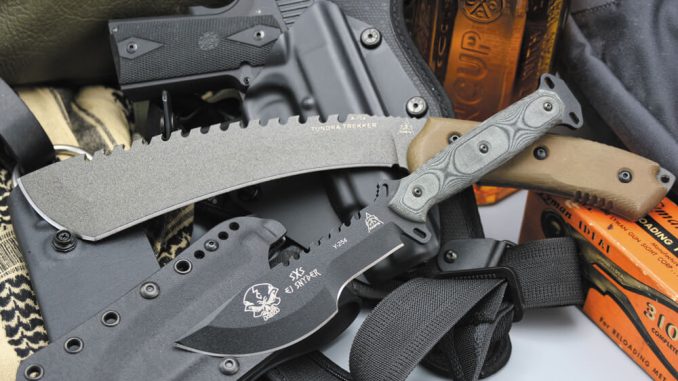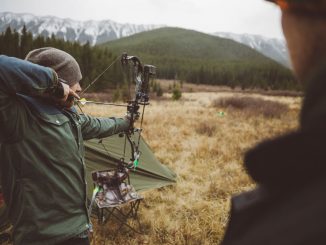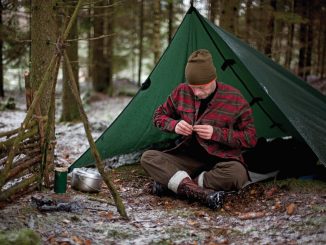
In 2018 I planned a road trip through New Jersey when a small storm passed through and dropped 3 to 4 inches of snow. The new governor, Phil Murphy, was not familiar with the weather process and did not mobilize the salt trucks and plows. As a result, it took me over six hours to go 20 miles, all because of some minor road conditions.
What this made me recognize is that bugging out, or even sheltering in place, may not always be an option. Safety may not be in the immediate area, and the time it takes to travel from one location to the next could take hours or even weeks. Additionally, in urban areas the number of people on the move will greatly limit options available on foot or in a vehicle.
When to Bug Out
It’s problematic to pinpoint the perfect time to bug out. There will be the inevitable monkey wrenches that will befall any plan that’s been put together. It’s commonly agreed that an early bug-out is the best option and I’m not one to disagree. The earlier you can get on the move, the less likely you will be to run into the under-prepared.
When you do run into these folks, your ability to appear as vulnerable as them takes a bit of the pressure off you. It becomes easier to assess the situation and arrange the next course of action when you don’t have to contend with the immediate danger of being targeted by the needy.
There will be moments, like natural disasters, that will make it difficult to get ahead of everyone else. In these situations, having your gear and movements organized and planned long ahead of time will speed up the bug-out preparations. For example, don’t plan on bringing every firearm you own. Because some will be left behind, pack only the ammunition needed for the firearms being taken. That ammunition can be set into crates that are accessible and easy to pack. Likewise, there should always be a box of dry food and pet supplies ready to go at a moment’s notice. Because of this preplanned packing, it will take less time to depart and get away from danger instead of packing the proverbial bread and milk.
Vehicle Movement
4-Wheel Vehicles
A person’s home is their castle, but their vehicle is their base camp. Cars, SUVs and trucks offer the ability to carry many necessary items with little effort. It’s crucial to make sure it doesn’t appear as if you possess valuable items. Also, anticipate the possibility of needing to abandon the vehicle in the event of a secondary emergency or major congestion when leaving urban areas.
“The goal should be that any moment someone looks inside the main cabin of your vehicle, they will see only what is commonplace.”

A lockable hard-sided roof cargo system is a great way to hide necessary items in plain sight. However, it’s likely to attract curiosity if local supplies are short and public order is declining.

A rooftop storage system that opens from both sides will make it easy to remove necessary items quickly and efficiently, no matter the obstacle.
Small AWD cars are great as not many people expect them to be transporting potentially lethal or valuable supplies. While a lifted truck with pro-2A stickers and a “Back the Blue” bumper sticker may be a more attractive off-road alternative, it will receive a lot of attention. With the addition of a quality roof rack and storage system on the car, you can easily haul more cargo without it being in the public eye. Realistically, a vehicle should not stand out and should blend in with all other vehicles. Think of it as a “graymobile.”
Packing
Packing is challenging because you need to make sure all necessary equipment is inside the vehicle and secondary equipment is outside on the roof rack. This means not weighing down suspension so it looks like you possess valuable and heavy items (e.g., ammunition, water or fuel) in the rear of your vehicle. Keep heavy items centered in the trunk and as far forward as possible and over or forward of the rear axle. If you pack the sides with lighter but equally essential items, you’ll be more able to balance the weight and avoid detection.

Packing so that the weight is evenly balanced is a necessary step to remaining unnoticed.

One benefit of aftermarket systems such as this Yakima roof rack is the ability to move them from vehicle to vehicle and to modify them for specific needs.
The goal should be that any moment someone looks inside the main cabin of your vehicle, they will see only what is commonplace. Weapons, fuel, valuables and food should stay out of sight. While most people wouldn’t bat an eye at a pillow, they will notice boxes of ammunition within arm’s reach. If “interesting” items are visible, they may be more inclined to investigate and try to take items to augment their own kit.

From a distance, a roof rack system looks like any other family vacation vehicle accessory and leaves room for other attachments.

Necessary items that take up valuable space can easily fit in an overhead system and remain accessible during camp setup.
Frequently used items that need to remain out of sight may include sleeping bags, tents, rifle bags, stoves and medical kits. All of these are lightweight enough to fit overhead in a roof rack system out of the weather. Other items need to remain close at hand. Food, drinking water, fuel and defensive weapons may not be used as much but need to be readily available. Vehicles with back seat pass-throughs offer unique advantages for keeping these items hidden and accessible even when on the move.
Motorcycles
Motorcycles are a different story. They have some critical flaws in terms of capacity. Sure, they can accommodate a trailer, but there is no way to carry additional fuel, water, firearms or other necessary gear out of view, other than with packs or standard motorcycle cargo rigs. While the two-wheeler’s size will give one the ability to move through congestion, range, seating and capacity will be severely limited. It’s also important to note a person’s physical appearance will attract attention. Obviously, an individual wearing full body armor and carrying a large rifle will attract more attention than someone wearing normal street clothes or riding gear.
“While the two-wheeler’s size will give one the ability to move through congestion, range, seating and capacity will be severely limited.”

While motorcycles have serious advantages to cars, they also lack space and require unique tools when they break down.

A small bag can hide a lot of necessary equipment in an innocuous container.

An old Swiss Army bread bag can easily hold an entire survival kit with room to spare. Knowing how to use the gear is a different matter.
For me, the major drawbacks to motorcycles, and why I do not recommend them for bugging out, are their lack of weather protection and discreet storage capacity and their short range. Plus, repairing a tire or changing the oil may require specialty tools not available in all locations. They could be a good scout vehicle for supporting a larger group but are not very efficient as a stand-alone BOV.
Foot Traffic
When it’s time to abandon your vehicle or if all the roads are shut down, it’s time to gather your gear and walk. Now you have a choice to make: Do you blend in and potentially sacrifice some safety equipment or gear up like you’re heading to war? Neither is bad or wrong, but each comes with inherent risks.
Gray Man
Personally, my favorite. A Gray Man kit-up is just hiding in plain sight. Books upon books have been written about how to successfully execute this. The reality is that it all depends on your circumstances. If everyone is geared up for war and you have a neon shirt that promotes some construction company, it’s not working.

Sleep systems such as the Zenbivy are often overlooked when preparing for a long bug-out plan.
Blending in does not mean unprepared nor under-prepared. However, the skills may be different if the focus is on staying under the radar. Tactical self-defense skills, concealment and foraging will be a better focus than assault. Don’t get me wrong, defending one’s self is equally important, but avoiding potential altercations remains the primary focus. In this type of bug-out, the goal is to remain inconspicuous. Keep all items hidden as well as possible, and don’t do anything against the status quo that will cause people to notice and remember you.

Back seats are prone to prying eyes. With routine and boring equipment in plain sight, attention is sent elsewhere.
Firearms and armor are still an essential element. Loose-fitting shirts or sweatshirts may allow for soft armor and pistols to be easily concealed, while a backpack can house a more formidable firearm. In reality, when it comes to an emergency situation lasting a long period of time, baggy clothes might be what everyone is wearing, especially if there is a food shortage.

There should be a few items quickly at hand if you need to bail out of your vehicle and begin to move on foot.

Alcohol is not only for drinking but can be used as an antiseptic and for trading. Consumable items will quickly become hard to find in serious emergencies.
If defense is not the primary goal but a secondary concern, smaller-caliber firearms can be hidden in a backpack lined with soft armor. One of my favorites is the Henry AR-7 survival rifle or Browning SA-22. The .22LR will still put food on the table, weighs only a few pounds and frees up enough space for hundreds of rounds of ammunition. This caliber and rifle aren’t battle-ready, but they still offer some level of defensive capability when needed.
Tactical
This is a main focus in many prepping plans. Many people talk about focusing on firearms, armor and accessories geared for battle. There is a time and place for such items, but it shouldn’t be the default. The deployment of tactical items is where my experience is limited so it’s something I train and prepare for.
“Everyone’s own bug-out plans will depend largely on their individual or group needs.”
Basic survival goods should remain the main priority. Following the necessities, firepower and armor are typically next.

Tactical options are easy to find and readily available. Choose your weapon carefully.
There are many options available to suit nearly every individual’s needs. Most of these items have the ability to adapt to changing situations. However, there are times when a self-assembled tactical kit may offer some benefit. Premade kits may be expensive, but they are often assembled by individuals with firsthand combat experience. It will be up to you to learn how to use these loadouts effectively.

The author demonstrates an offensive/defensive tactical kit after transitioning from a simple gray man setup when a significant threat is recognized.
The largest issue with a tactical bug-out can be the weight carried. Armor, weapons and ammunition add up fast. Many common rifles can weigh upwards of 10 pounds without ammunition and accessories.
“Basic survival goods should remain the main priority. Following the necessities, firepower and armor are typically next. There are many options available to suit nearly every individual’s needs.”

The TOPS SXS can fit the role of a bushcraft knife while not sacrificing tactical capabilities. From building shelters and making feather sticks to armed defense, it can fill the role.
Having the ability to shed weight without losing ammunition is one possible benefit of the tactical setup. The bulkiest item needed would be a plate carrier. When a user affixes magazine pouches directly to the plate carrier, they’re stuck with that setup. Using a chest rig over a plate carrier or a hybrid will allow a user to remove one unnecessary item without sacrificing the other.
Conclusion
Everyone’s own bug-out plans will depend largely on their individual or group needs. While I may recommend a small vehicle packed full of gear, a family of four will have a harder time and need to make appropriate adjustments.
However, the same principles hold true. Lacking the proper planning and placement may arouse suspicion in areas never planned out. A vehicle trunk weighed down with thousands of rounds of ammunition, water and fuel may raise a few eyebrows when the tires are rubbing the wheel wells. A minivan or SUV are probably more compatible with the needs and optics of a family or similar group.
Be Rested, Be Ready
When planning for a bug-out, there are often overlooked preps, such as sleep systems and tradable consumables.
Sleep systems are essential as a primary source of heat conservation during frigid nights and the primary means of staying sufficiently rested. Tired eyes and brains will be more likely to make mistakes. Sleep deprivation training is only useful when you know how you must act when you are well rested. Training and learning personal physical and mental limits are why sleep deprivation works during military training.
To this end, a lightweight and efficient system such as the Zenbivy, may be worth its weight in gold. Lightweight, easy to carry, well-constructed and modular, it outperforms many other sleep systems. There may be some issues with being brightly colored or slightly less rugged, but if care is taken the Zenbivy will provide the comfort and support needed during a tense time.
Likewise, another overlooked item is alcohol. Alcohol is a consumable and will last only a certain amount of time. While it’s finite, it offers uses with sterilization, cooking and trading. Any alcohol over 80 proof can be used to sterilize wounds to prevent infection. This is a main selling point for trade. Having alcohol on hand may allow trading for necessary items to keep a person safe.
Suggested Items to Keep in Your BOV:
Tent: Lightweight tents are compact and will not affect gas mileage.
Binoculars: They offer a range of magnifications and features and wider field of view than weapon scopes.
Water container: Pick a size to accommodate your water needs.
Knife: There is always the need for one or more knives.
Dry containers: Ammo crates from Plano offer great storage possibilities for ammunition or other items.
Alcohol: For medical use, cooking or trading, alcohol should always be available.
Yakima Roof Rack: While not the only option, it’s a good way to pack necessary items.
Zenbivy: Compressible lightweight sleep systems help keep you healthy.
Clothing: Carry items suitable for the season and other needs in a clean bag or other container.
Books: How-to and reference books are a great backup to training and skills.
GEAR Ideas
Tactical preps don’t have to cost a lot of money, but there is usually a correlation between cost and quality. Many companies produce their own armor carriers, harnesses, pouches and holsters. If you’re on a budget, the NcStar soft armor will offer some protection. While it’s not the best, it’s inexpensive and sufficient for emergency use. Likewise, Condor Outdoor creates some efficient and useful pouches, clothing, vests and gear. Again, it doesn’t cost a fortune, but they are a bit heavier and more fragile than big-name alternatives.
When choosing tactical items, it’s important to plan for what might come. If you’re staying local and moving from one location to another, then a minimal number of items are needed. If you’re moving a long distance, it’s important to plan for every eventuality. In these cases, take tactical items that can be adapted to different types of firearms encountered or carried. Better yet, train with multiple platforms and figure out the best option for yourself and how to adapt your gear for changing eventualities.
Editor’s note: A version of this article first appeared in the June, 2020 print issue of American Survival Guide.






Be the first to comment